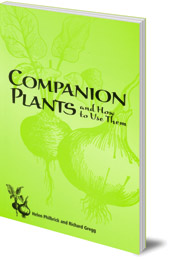Quick Look
A detailed and comprehensive A-Z reference book of plants and how they affect each other favourably and unfavourably.
Description
It has long been observed that certain plants can affect others growing near them – both favourably and unfavourably. Being aware of these relationships can help improve the quality of the food and flowers we grow, and reduce losses from pests and disease.
Drawing on the expertise of companion planting
pioneer Richard B. Gregg, as well as the research of Helen Philbrick and others, this unique reference book offers an A to Z of plants and how they affect each other and their surroundings, including the soil, insects and birds.
From apple trees to spearmint, and garlic to yarrow, this handy look-up guide will help you quickly discover how to improve the growth of your crops, plants and flowers.
Reviews
'Any grower, whether working in large fields or small gardens, should find Companion Plants and How to Use Them an invauable guide to what to plant and where to plant. Having a knowledge of the mutual influence of one living organism on another is indispensable, especially for those working in organic or biodynamic situations where there is a need to combat plant pests and diseases without resorting to the use of toxic substanes. Following the advice given in this book may well lead to improved results in the quality, resilience and yield of plants and help avoid the failures and disappointments that might ensue from unwittingly placing plants that are not the best of friends in close proximity.'
--New View
Author
Helen Philbrick (1910-2011) worked with Richard Gregg and Evelyn Speiden Gregg to experiment with companion planting. She wrote extensively on the subject.
Richard Gregg was an early pioneer of companion planting. In the 1940s, he and Evelyn Speiden Gregg used their own garden to experiment with different plants.
Links
This book is an updated and revised edition of the older pamphlet by Richard Gregg, Primer of Companion Planting, which is now out of print. The information in Companion Plants is organised in a different way, but all the great tips and and insights from the older book are included.
You may also be interested in our other biodynamic books:
Pfeiffer's Introduction to Biodynamics
Weeds and What They Tell Us
Koepf's Practical Biodynamics
Biodynamic Manual

